Stryker Corporation: A Financial Analysis of PCB In-sourcing Project
VerifiedAdded on 2020/04/13
|6
|984
|41
Project
AI Summary
This corporate finance project analyzes Stryker Corporation's decision to in-source the production of printed circuit boards (PCBs). The project evaluates three options: maintaining the status quo with modifications, establishing a relationship with a single supplier, and insourcing PCB production. The analysis focuses on the third option, which involves significant capital investment. The project includes an executive summary, financial appraisal techniques such as Net Present Value (NPV), Payback Period, and Internal Rate of Return (IRR), and sensitivity analysis. The project also examines incremental cash flows, the terminal value of the project, and the payback period, concluding with a negative NPV, indicating the project's financial viability. The report also considers the strategic implications, risk factors, and the decision-making process involved in capital budgeting for the PCB project, including a review process at different stages.
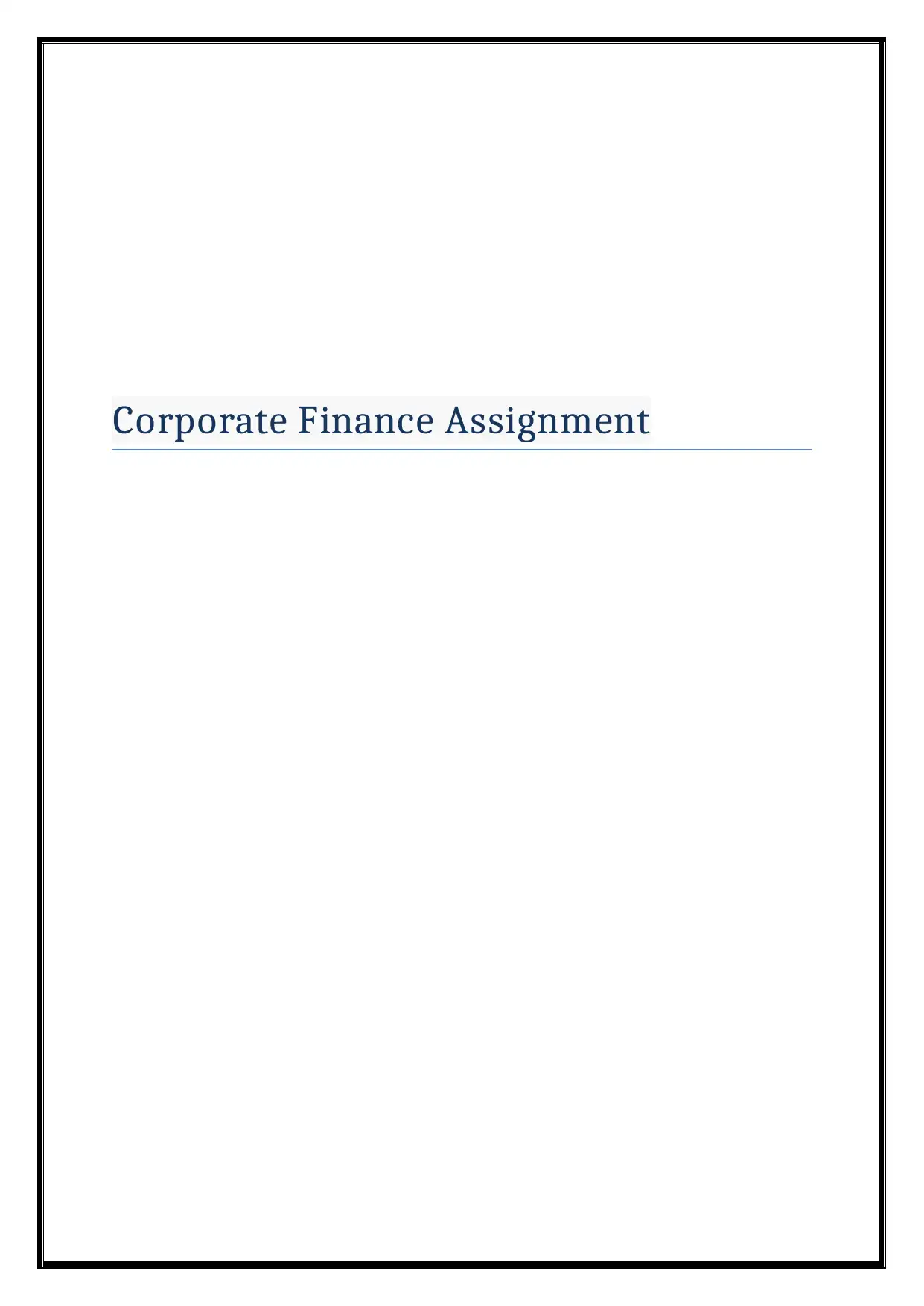
Corporate Finance Assignment
Paraphrase This Document
Need a fresh take? Get an instant paraphrase of this document with our AI Paraphraser
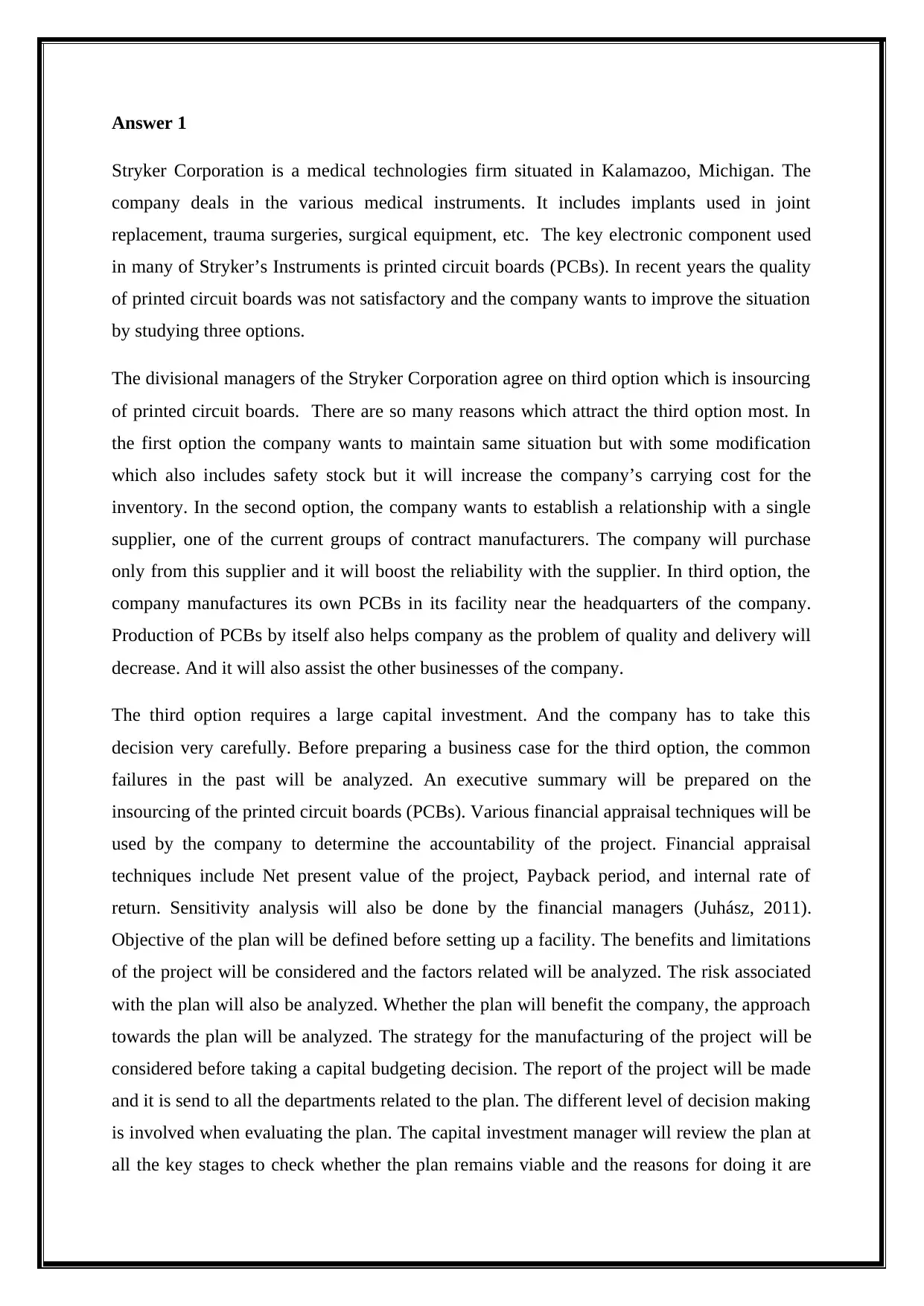
Answer 1
Stryker Corporation is a medical technologies firm situated in Kalamazoo, Michigan. The
company deals in the various medical instruments. It includes implants used in joint
replacement, trauma surgeries, surgical equipment, etc. The key electronic component used
in many of Stryker’s Instruments is printed circuit boards (PCBs). In recent years the quality
of printed circuit boards was not satisfactory and the company wants to improve the situation
by studying three options.
The divisional managers of the Stryker Corporation agree on third option which is insourcing
of printed circuit boards. There are so many reasons which attract the third option most. In
the first option the company wants to maintain same situation but with some modification
which also includes safety stock but it will increase the company’s carrying cost for the
inventory. In the second option, the company wants to establish a relationship with a single
supplier, one of the current groups of contract manufacturers. The company will purchase
only from this supplier and it will boost the reliability with the supplier. In third option, the
company manufactures its own PCBs in its facility near the headquarters of the company.
Production of PCBs by itself also helps company as the problem of quality and delivery will
decrease. And it will also assist the other businesses of the company.
The third option requires a large capital investment. And the company has to take this
decision very carefully. Before preparing a business case for the third option, the common
failures in the past will be analyzed. An executive summary will be prepared on the
insourcing of the printed circuit boards (PCBs). Various financial appraisal techniques will be
used by the company to determine the accountability of the project. Financial appraisal
techniques include Net present value of the project, Payback period, and internal rate of
return. Sensitivity analysis will also be done by the financial managers (Juhász, 2011).
Objective of the plan will be defined before setting up a facility. The benefits and limitations
of the project will be considered and the factors related will be analyzed. The risk associated
with the plan will also be analyzed. Whether the plan will benefit the company, the approach
towards the plan will be analyzed. The strategy for the manufacturing of the project will be
considered before taking a capital budgeting decision. The report of the project will be made
and it is send to all the departments related to the plan. The different level of decision making
is involved when evaluating the plan. The capital investment manager will review the plan at
all the key stages to check whether the plan remains viable and the reasons for doing it are
Stryker Corporation is a medical technologies firm situated in Kalamazoo, Michigan. The
company deals in the various medical instruments. It includes implants used in joint
replacement, trauma surgeries, surgical equipment, etc. The key electronic component used
in many of Stryker’s Instruments is printed circuit boards (PCBs). In recent years the quality
of printed circuit boards was not satisfactory and the company wants to improve the situation
by studying three options.
The divisional managers of the Stryker Corporation agree on third option which is insourcing
of printed circuit boards. There are so many reasons which attract the third option most. In
the first option the company wants to maintain same situation but with some modification
which also includes safety stock but it will increase the company’s carrying cost for the
inventory. In the second option, the company wants to establish a relationship with a single
supplier, one of the current groups of contract manufacturers. The company will purchase
only from this supplier and it will boost the reliability with the supplier. In third option, the
company manufactures its own PCBs in its facility near the headquarters of the company.
Production of PCBs by itself also helps company as the problem of quality and delivery will
decrease. And it will also assist the other businesses of the company.
The third option requires a large capital investment. And the company has to take this
decision very carefully. Before preparing a business case for the third option, the common
failures in the past will be analyzed. An executive summary will be prepared on the
insourcing of the printed circuit boards (PCBs). Various financial appraisal techniques will be
used by the company to determine the accountability of the project. Financial appraisal
techniques include Net present value of the project, Payback period, and internal rate of
return. Sensitivity analysis will also be done by the financial managers (Juhász, 2011).
Objective of the plan will be defined before setting up a facility. The benefits and limitations
of the project will be considered and the factors related will be analyzed. The risk associated
with the plan will also be analyzed. Whether the plan will benefit the company, the approach
towards the plan will be analyzed. The strategy for the manufacturing of the project will be
considered before taking a capital budgeting decision. The report of the project will be made
and it is send to all the departments related to the plan. The different level of decision making
is involved when evaluating the plan. The capital investment manager will review the plan at
all the key stages to check whether the plan remains viable and the reasons for doing it are
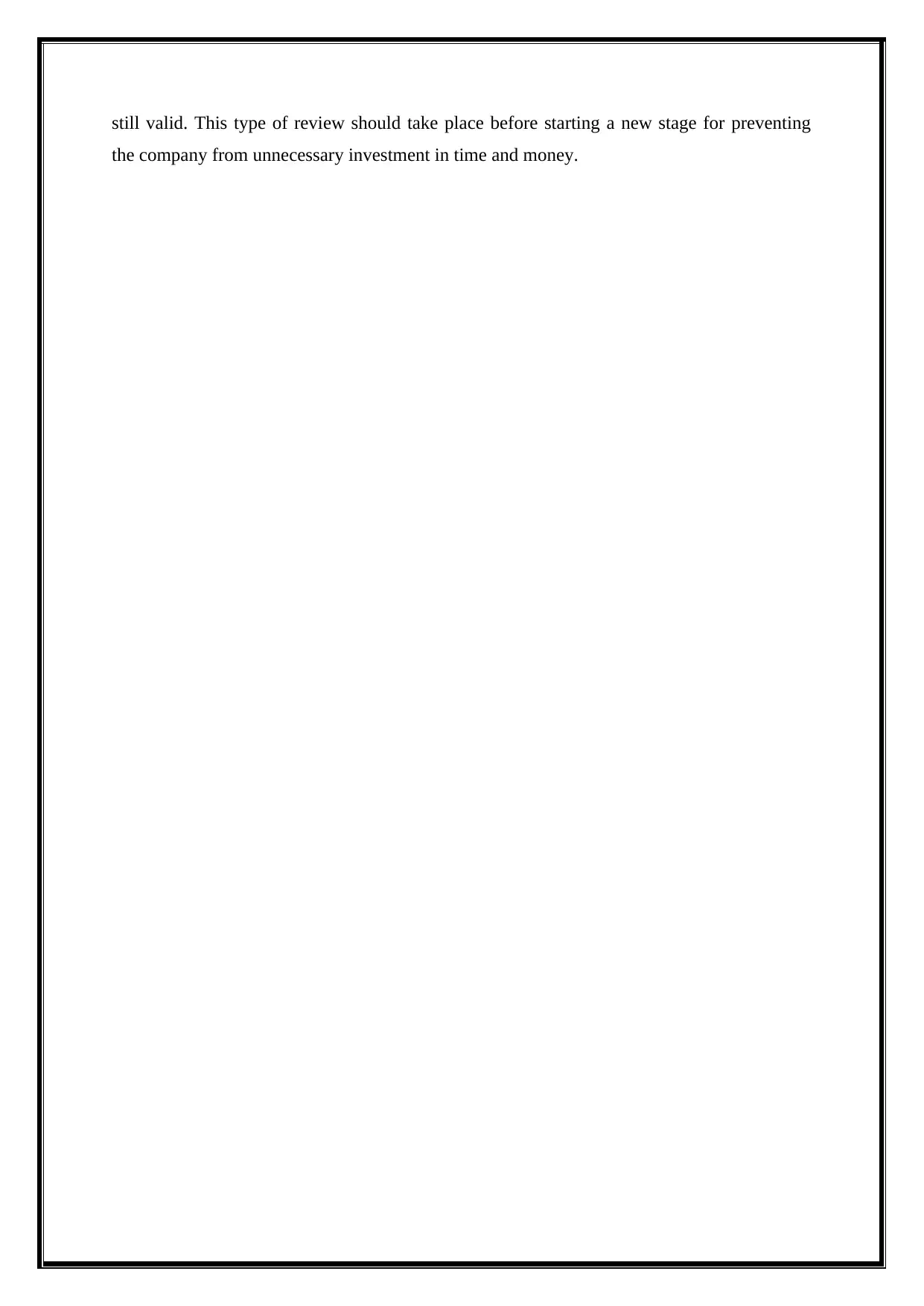
still valid. This type of review should take place before starting a new stage for preventing
the company from unnecessary investment in time and money.
the company from unnecessary investment in time and money.
⊘ This is a preview!⊘
Do you want full access?
Subscribe today to unlock all pages.

Trusted by 1+ million students worldwide
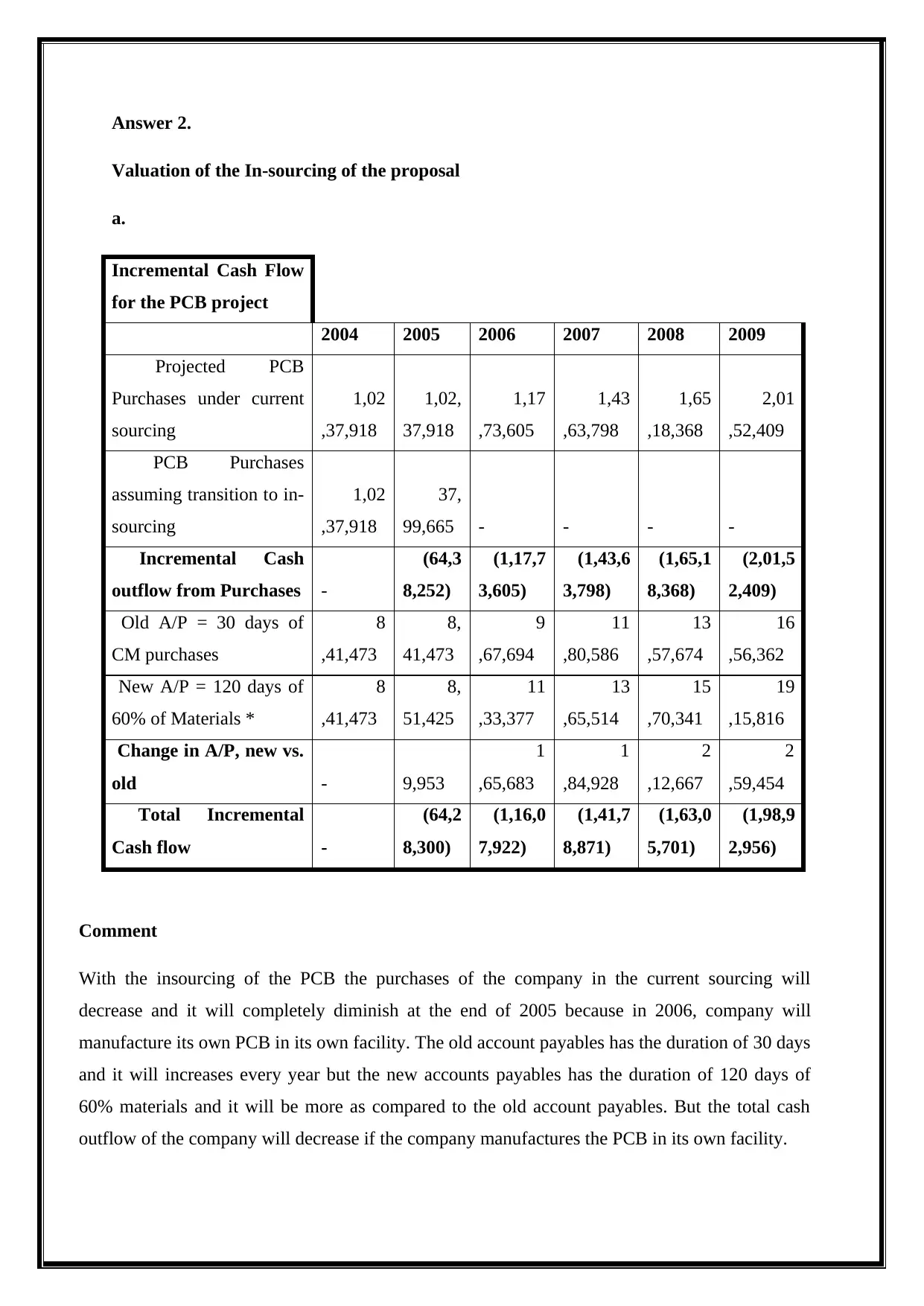
Answer 2.
Valuation of the In-sourcing of the proposal
a.
Incremental Cash Flow
for the PCB project
2004 2005 2006 2007 2008 2009
Projected PCB
Purchases under current
sourcing
1,02
,37,918
1,02,
37,918
1,17
,73,605
1,43
,63,798
1,65
,18,368
2,01
,52,409
PCB Purchases
assuming transition to in-
sourcing
1,02
,37,918
37,
99,665 - - - -
Incremental Cash
outflow from Purchases -
(64,3
8,252)
(1,17,7
3,605)
(1,43,6
3,798)
(1,65,1
8,368)
(2,01,5
2,409)
Old A/P = 30 days of
CM purchases
8
,41,473
8,
41,473
9
,67,694
11
,80,586
13
,57,674
16
,56,362
New A/P = 120 days of
60% of Materials *
8
,41,473
8,
51,425
11
,33,377
13
,65,514
15
,70,341
19
,15,816
Change in A/P, new vs.
old - 9,953
1
,65,683
1
,84,928
2
,12,667
2
,59,454
Total Incremental
Cash flow -
(64,2
8,300)
(1,16,0
7,922)
(1,41,7
8,871)
(1,63,0
5,701)
(1,98,9
2,956)
Comment
With the insourcing of the PCB the purchases of the company in the current sourcing will
decrease and it will completely diminish at the end of 2005 because in 2006, company will
manufacture its own PCB in its own facility. The old account payables has the duration of 30 days
and it will increases every year but the new accounts payables has the duration of 120 days of
60% materials and it will be more as compared to the old account payables. But the total cash
outflow of the company will decrease if the company manufactures the PCB in its own facility.
Valuation of the In-sourcing of the proposal
a.
Incremental Cash Flow
for the PCB project
2004 2005 2006 2007 2008 2009
Projected PCB
Purchases under current
sourcing
1,02
,37,918
1,02,
37,918
1,17
,73,605
1,43
,63,798
1,65
,18,368
2,01
,52,409
PCB Purchases
assuming transition to in-
sourcing
1,02
,37,918
37,
99,665 - - - -
Incremental Cash
outflow from Purchases -
(64,3
8,252)
(1,17,7
3,605)
(1,43,6
3,798)
(1,65,1
8,368)
(2,01,5
2,409)
Old A/P = 30 days of
CM purchases
8
,41,473
8,
41,473
9
,67,694
11
,80,586
13
,57,674
16
,56,362
New A/P = 120 days of
60% of Materials *
8
,41,473
8,
51,425
11
,33,377
13
,65,514
15
,70,341
19
,15,816
Change in A/P, new vs.
old - 9,953
1
,65,683
1
,84,928
2
,12,667
2
,59,454
Total Incremental
Cash flow -
(64,2
8,300)
(1,16,0
7,922)
(1,41,7
8,871)
(1,63,0
5,701)
(1,98,9
2,956)
Comment
With the insourcing of the PCB the purchases of the company in the current sourcing will
decrease and it will completely diminish at the end of 2005 because in 2006, company will
manufacture its own PCB in its own facility. The old account payables has the duration of 30 days
and it will increases every year but the new accounts payables has the duration of 120 days of
60% materials and it will be more as compared to the old account payables. But the total cash
outflow of the company will decrease if the company manufactures the PCB in its own facility.
Paraphrase This Document
Need a fresh take? Get an instant paraphrase of this document with our AI Paraphraser
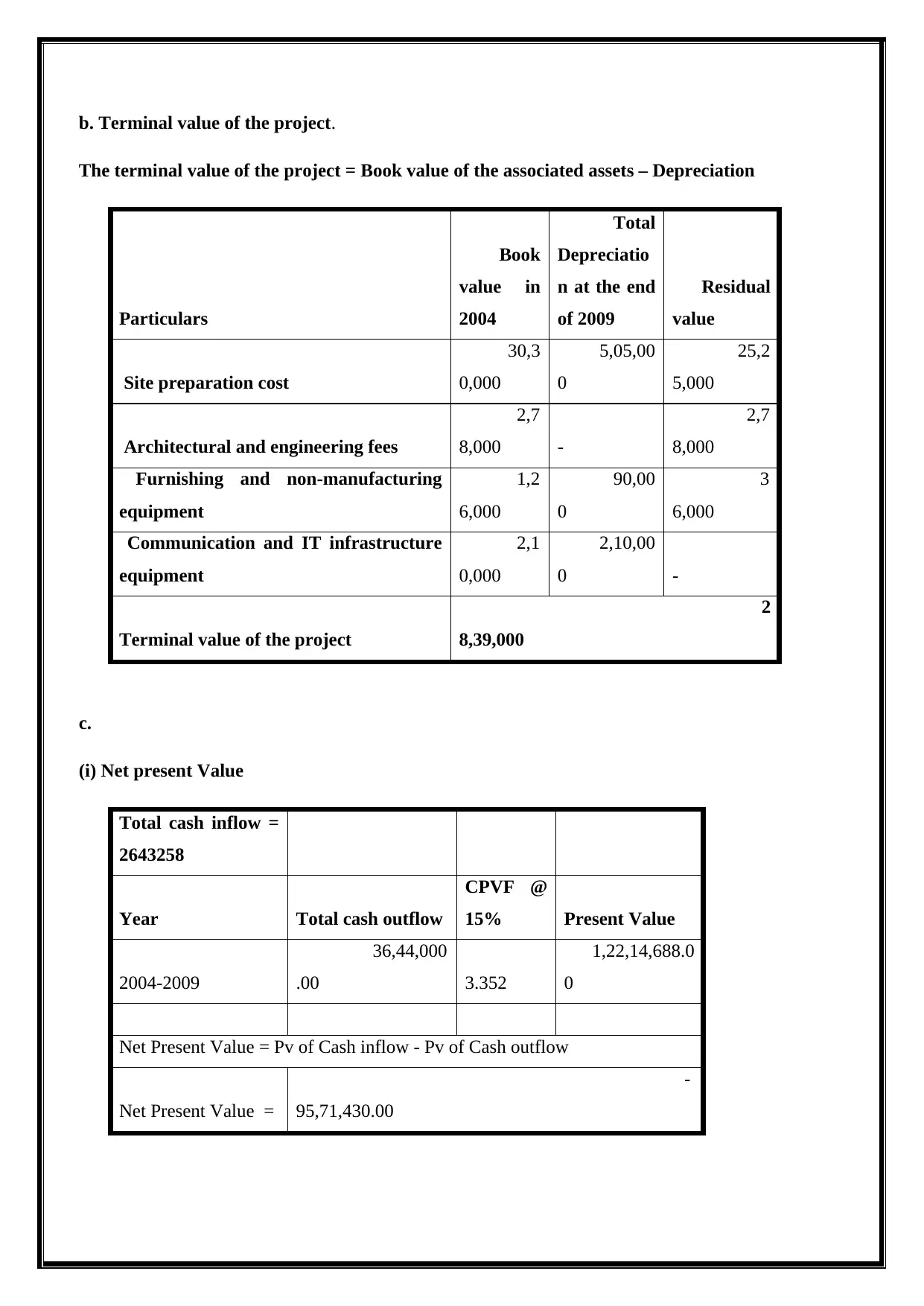
b. Terminal value of the project.
The terminal value of the project = Book value of the associated assets – Depreciation
Particulars
Book
value in
2004
Total
Depreciatio
n at the end
of 2009
Residual
value
Site preparation cost
30,3
0,000
5,05,00
0
25,2
5,000
Architectural and engineering fees
2,7
8,000 -
2,7
8,000
Furnishing and non-manufacturing
equipment
1,2
6,000
90,00
0
3
6,000
Communication and IT infrastructure
equipment
2,1
0,000
2,10,00
0 -
Terminal value of the project
2
8,39,000
c.
(i) Net present Value
Total cash inflow =
2643258
Year Total cash outflow
CPVF @
15% Present Value
2004-2009
36,44,000
.00 3.352
1,22,14,688.0
0
Net Present Value = Pv of Cash inflow - Pv of Cash outflow
Net Present Value =
-
95,71,430.00
The terminal value of the project = Book value of the associated assets – Depreciation
Particulars
Book
value in
2004
Total
Depreciatio
n at the end
of 2009
Residual
value
Site preparation cost
30,3
0,000
5,05,00
0
25,2
5,000
Architectural and engineering fees
2,7
8,000 -
2,7
8,000
Furnishing and non-manufacturing
equipment
1,2
6,000
90,00
0
3
6,000
Communication and IT infrastructure
equipment
2,1
0,000
2,10,00
0 -
Terminal value of the project
2
8,39,000
c.
(i) Net present Value
Total cash inflow =
2643258
Year Total cash outflow
CPVF @
15% Present Value
2004-2009
36,44,000
.00 3.352
1,22,14,688.0
0
Net Present Value = Pv of Cash inflow - Pv of Cash outflow
Net Present Value =
-
95,71,430.00

(ii) Payback period of the project is 5 years. As the project takes five years for the completion and
the cash outflow of the five years describes that the project can help the company in maintaining
quality (Salehi, 2009).
the cash outflow of the five years describes that the project can help the company in maintaining
quality (Salehi, 2009).
⊘ This is a preview!⊘
Do you want full access?
Subscribe today to unlock all pages.

Trusted by 1+ million students worldwide
1 out of 6
Related Documents
Your All-in-One AI-Powered Toolkit for Academic Success.
+13062052269
info@desklib.com
Available 24*7 on WhatsApp / Email
![[object Object]](/_next/static/media/star-bottom.7253800d.svg)
Unlock your academic potential
Copyright © 2020–2025 A2Z Services. All Rights Reserved. Developed and managed by ZUCOL.





